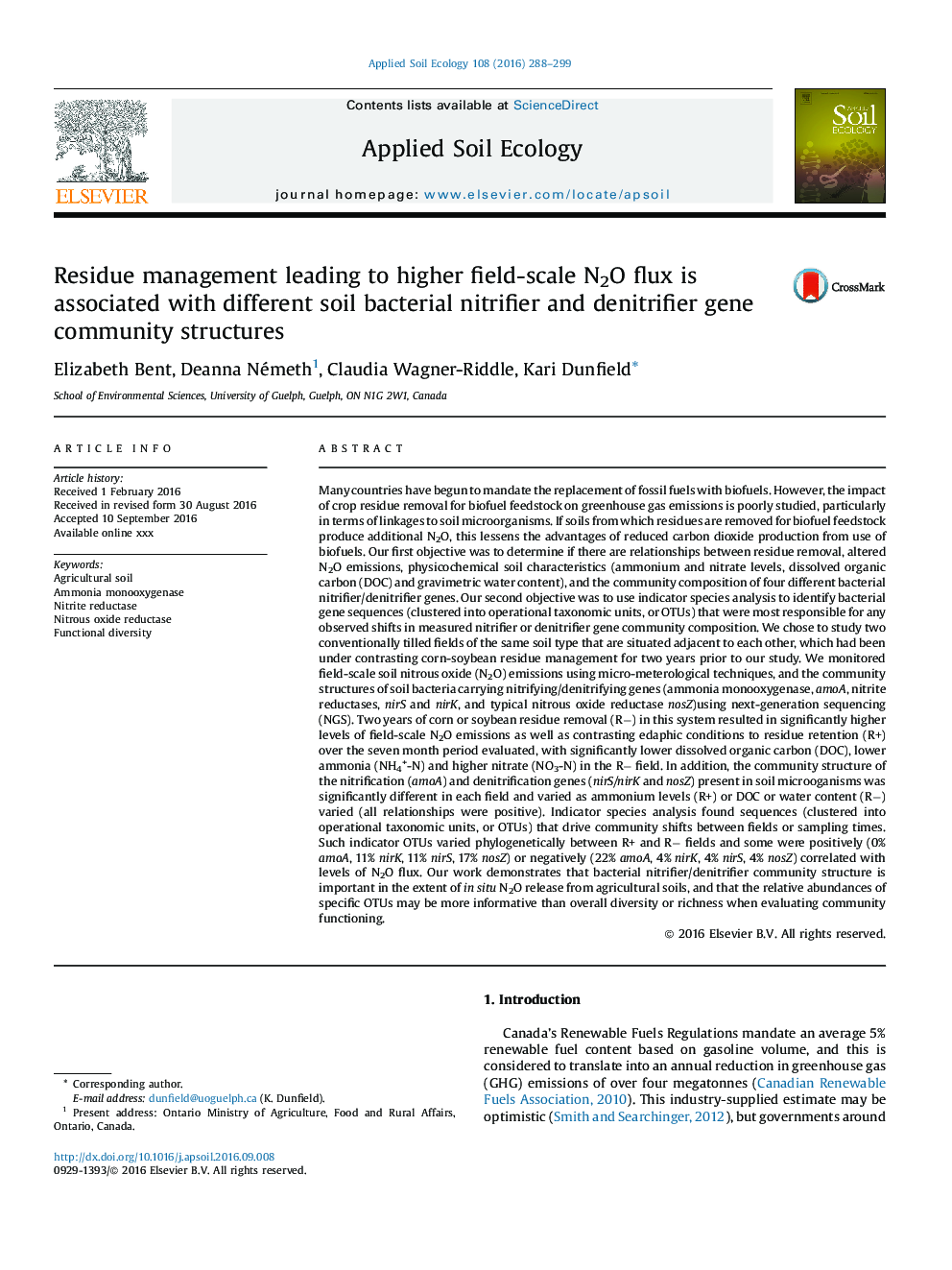| کد مقاله | کد نشریه | سال انتشار | مقاله انگلیسی | نسخه تمام متن |
|---|---|---|---|---|
| 6297491 | 1617775 | 2016 | 12 صفحه PDF | دانلود رایگان |
عنوان انگلیسی مقاله ISI
Residue management leading to higher field-scale N2O flux is associated with different soil bacterial nitrifier and denitrifier gene community structures
دانلود مقاله + سفارش ترجمه
دانلود مقاله ISI انگلیسی
رایگان برای ایرانیان
کلمات کلیدی
موضوعات مرتبط
علوم زیستی و بیوفناوری
علوم کشاورزی و بیولوژیک
بوم شناسی، تکامل، رفتار و سامانه شناسی
پیش نمایش صفحه اول مقاله

چکیده انگلیسی
Many countries have begun to mandate the replacement of fossil fuels with biofuels. However, the impact of crop residue removal for biofuel feedstock on greenhouse gas emissions is poorly studied, particularly in terms of linkages to soil microorganisms. If soils from which residues are removed for biofuel feedstock produce additional N2O, this lessens the advantages of reduced carbon dioxide production from use of biofuels. Our first objective was to determine if there are relationships between residue removal, altered N2O emissions, physicochemical soil characteristics (ammonium and nitrate levels, dissolved organic carbon (DOC) and gravimetric water content), and the community composition of four different bacterial nitrifier/denitrifier genes. Our second objective was to use indicator species analysis to identify bacterial gene sequences (clustered into operational taxonomic units, or OTUs) that were most responsible for any observed shifts in measured nitrifier or denitrifier gene community composition. We chose to study two conventionally tilled fields of the same soil type that are situated adjacent to each other, which had been under contrasting corn-soybean residue management for two years prior to our study. We monitored field-scale soil nitrous oxide (N2O) emissions using micro-meterological techniques, and the community structures of soil bacteria carrying nitrifying/denitrifying genes (ammonia monooxygenase, amoA, nitrite reductases, nirS and nirK, and typical nitrous oxide reductase nosZ)using next-generation sequencing (NGS). Two years of corn or soybean residue removal (Râ) in this system resulted in significantly higher levels of field-scale N2O emissions as well as contrasting edaphic conditions to residue retention (R+) over the seven month period evaluated, with significantly lower dissolved organic carbon (DOC), lower ammonia (NH4+-N) and higher nitrate (NO3-N) in the Râ field. In addition, the community structure of the nitrification (amoA) and denitrification genes (nirS/nirK and nosZ) present in soil microoganisms was significantly different in each field and varied as ammonium levels (R+) or DOC or water content (Râ) varied (all relationships were positive). Indicator species analysis found sequences (clustered into operational taxonomic units, or OTUs) that drive community shifts between fields or sampling times. Such indicator OTUs varied phylogenetically between R+ and Râ fields and some were positively (0% amoA, 11% nirK, 11% nirS, 17% nosZ) or negatively (22% amoA, 4% nirK, 4% nirS, 4% nosZ) correlated with levels of N2O flux. Our work demonstrates that bacterial nitrifier/denitrifier community structure is important in the extent of in situ N2O release from agricultural soils, and that the relative abundances of specific OTUs may be more informative than overall diversity or richness when evaluating community functioning.
ناشر
Database: Elsevier - ScienceDirect (ساینس دایرکت)
Journal: Applied Soil Ecology - Volume 108, December 2016, Pages 288-299
Journal: Applied Soil Ecology - Volume 108, December 2016, Pages 288-299
نویسندگان
Elizabeth Bent, Deanna Németh, Claudia Wagner-Riddle, Kari Dunfield,